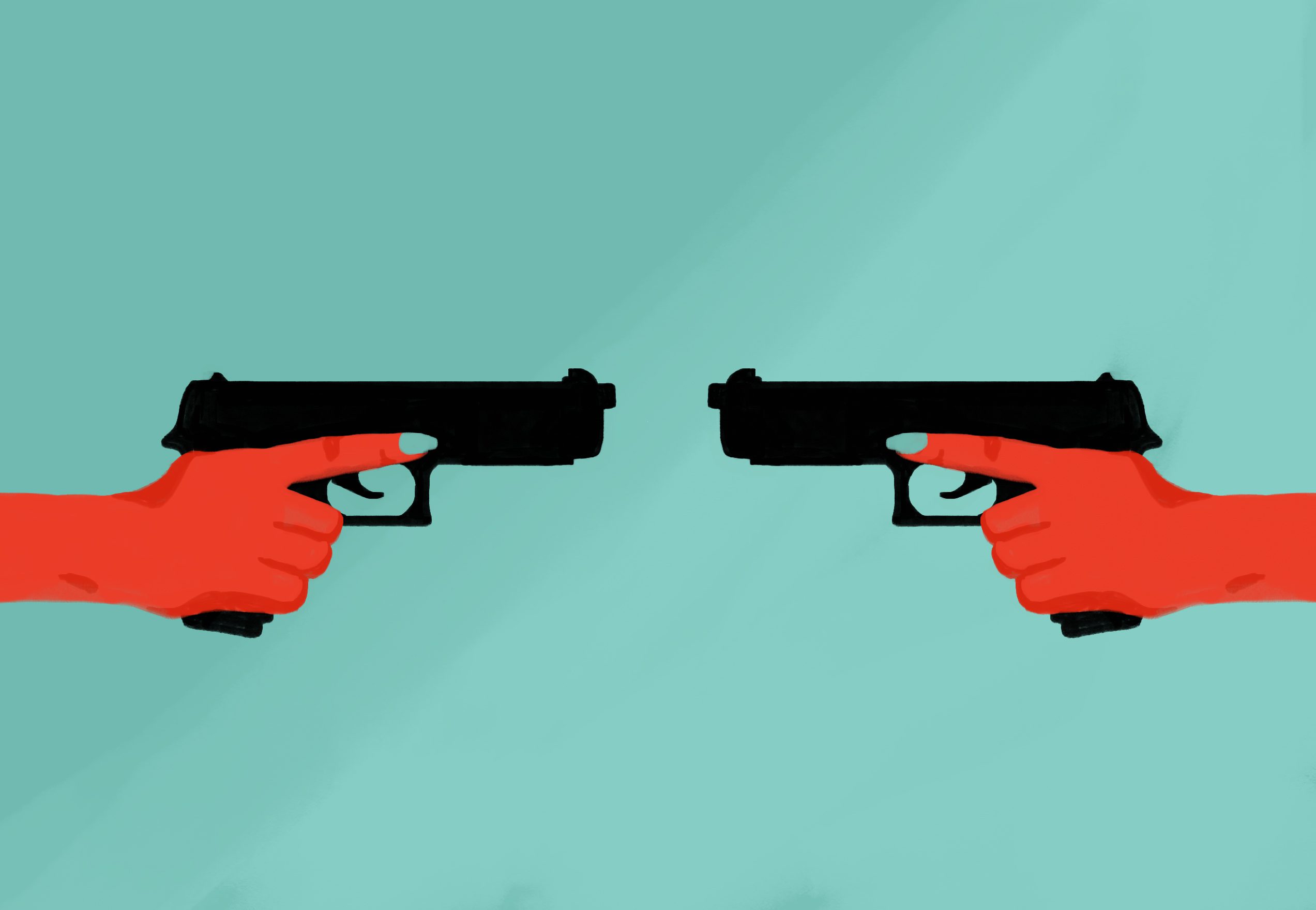I’ll never forget how exhilarated I felt the first time I watched “Pixies,” the ninth episode of the second season of Law & Order: SVU.
“Pixies” begins as many SVU episodes do: with the discovery of a dead girl in an unexpected place. This time, the place is behind a dumpster outside a slaughterhouse, and the dead girl is a sixteen-year-old gymnastics prodigy named Kristy. As the episode unfolds, each scene reveals yet another sinister man in Kristy’s life. The pedophile who runs an adult video store around the corner. The domineering and manipulative gymnastics coach who holds her future in his hands. The predatory benefactor who videotapes their “consensual” sex sessions. The list of suspects is long and repulsive.
That’s what makes this episode’s twist so memorable; none of these vile men are responsible for her murder. No, the murderer is Lori, another hopeful gymnast, another teen girl shining with naivety and potential. She confesses that she beat Kristy to death in a jealous rage. During her confession, she sniffles and cries, but her words sizzle with bitterness: “Nobody ever cared about me. She got everything so easy. I do it all on my own.”
This episode was released on January 12, 2001 when I was nine years old. I didn’t see it then. I watched it two years later, when I was eleven and had begun binging TNT’s SVU marathons as though my life depended on it. In the thick miasma of SVU episodes that I call my mind, this episode stands out. I remember it clearly because I was gripped by its twist, held captive by Lori’s confession. As I watched Lori lean towards the detectives, I leaned towards the screen, as though our skulls were matching magnets.
Why did this episode affect me so? I think because “Pixies” was the first time I’d seen a murderer who looked like me. Here was a pubescent girl brimming with rage and ambition (portrayed excellently by a young Kate Mara, who was herself brimming with her own ambition). Here was a girl who proved herself capable of feats that I had previously thought only men were capable of. Lori was a revelation.
My hunger for murder mysteries featuring powerful women has only grown since my SVU marathons, and there’s no dearth of modern genre fiction to satiate that hunger.
In Gillian Flynn’s best-selling Gone Girl, Nick Dunne grumbles “It’s always the husband,” and he should know. He’s the husband of the married couple that Flynn examines in her novel, and since his wife Amy has mysteriously gone missing, he has faced intense media scrutiny.
The twist is, in this case, it’s not the husband. No, in the Dunnes’ case, the wife is the murderer. To wrap up her diabolical plan to punish her husband by faking her own kidnapping, Amy Elliot Dunne seduces an ex-boyfriend and then slashes him to pieces, reenacting the psychosexual violence we often see wrought upon women: “naked and drained, a stunned look on his face, a few strands of my hair in his clutches, the bed soaked in blood.”
To say that American audiences loved this twist is an understatement. Gone Girl was on the New York Times Hardcover Fiction Bestseller list for eight weeks and NPR’s Hardcover Fiction Bestseller list for twenty-six weeks. David Fincher’s movie adaptation ranked number one at the box office its opening weekend. The popularity of this novel and its film adaptation suggests we harbor an intense interest in women who murder.
Amy’s not the only one of her kind. Flynn’s first novel, Sharp Objects (whose HBO mini-series adaptation this past summer launched a thousand thinkpieces), features the crowning glory of lady killers: the cute teen girl slayer Amma. She is as homicidal as she is adorable: “She had peach skin, so free of blotches or wrinkles, her face so perfect and character-free she could have just popped out of the womb… she took her wet sucker and twirled it in my hair.” Amma’s violent tendencies simmer so close to her Lolita-like surface that, in her grasp, even a lollipop becomes a weapon.
A similar murderer makes her debut in Tana French’s best-selling In the Woods, which won four awards for best first novel: the Edgar Allan Poe Award, the Anthony Award, the Macavity Award, and the Barry Award. French’s seventeen-year-old Rosalind is a pitch-perfect rendition of Lori; she plots her younger sister’s murder because she’s jealous of the attention she receives for her ballet talents. After Detective Rob Ryan hears her confession, he bemoans: “I could no longer picture Rosalind in my mind’s eyes; the tender vision of the girl in white had been blown to pieces as if by a nuclear bomb.”
Rob’s words capture exactly what is so thrilling about these twists: the juxtaposition of these women’s pleasing appearances with their brutal deeds. The surprise of this contradiction is what made these books memorable and what rocketed these writers to literary stardom. Their success suggests that we’re desperate for women to join in on the fun of murder.
Perhaps we find these stories empowering. After all, these lady killers pitch themselves as symbols of empowerment to us. Amy spins murder as an act of radical feminist rebellion, justifying herself with a rant about the “cool girl” phenomenon. I found myself nodding involuntarily as I read her critique of the subtle misogyny that infects hetero-dating culture:
Being the Cool Girl means I am hot, brilliant, funny woman who adores football, poker, dirty jokes, and burping… I used to see men—friends, coworkers, strangers—giddy over these awful pretender women, and I’d want to sit these men down and calmly say: You are not dating a woman, you are dating a woman who has watched too many movies written by socially awkward men who’d like to believe that this kind of woman exists and might kiss them.
After I read this, I promised myself I would never pretend to like war movies again.
And Amma makes murder sound like the most fun a girl could have: “What if you hurt because it feels so good? Like you have a tingling, like someone left a switch on in your body. And nothing can turn the switch off except hurting.”
Gone Girl, Sharp Objects and In the Woods: these stories imagine women shattering the glass ceiling of homicide, pitching murder as the last feminist frontier. I find myself tempted to buy into the girl power branding because, more than a decade later, I still remember how excited I felt when I learned what Lori was capable of. However, while Flynn and French may be the most prominent peddlers of the “the woman did it” twist in recent history, they didn’t invent the trope. Bloodthirsty women have been a cornerstone of American art for generations. Their big entrance was the emergence of the femme fatale in noir films of the 1940s and 1950s.
Bring up Double Indemnity with any film buff and the first thing you’ll hear is how Barbara Stanwyck defined the femme fatale trope with her portrayal of Phyllis, a wife who wants to kill her husband and collect a life insurance jackpot, so she recruits insurance salesman Walter (Fred MacMurray) to help. Phyllis cut the mold for money-hungry, cold-hearted bitch.
What’s ironic about this legacy is the fact that Phyllis doesn’t kill her husband. Walter does. But the movie doesn’t want you to dwell on this. When the moment comes, the camera goes in for an intense close-up on Phyllis’s face, highlighting her excited expression as Walter does the deed. And don’t forget: the entire film is narrated by Walter so what we’re shown is explicitly his version of the events. We don’t know if Phyllis really looked so delighted during her husband’s murder because we never get her side of the story. Instead, we hear a version that conveniently avoids acknowledging the fact that it is Walter who literally wrings the life out of her husband.
Ultimately, Phyllis is most likely a fabrication of Walter’s imagination, one that enables him to shirk responsibility for killing a stranger. And consequently, the femme fatale became a fabrication of our shared imagination, a fantasy. Because, let’s be clear, it is a fantasy. Women don’t murder. Women make up a little more than half of the world’s population, but, as a US Department of Justice study from 1998 to 2008 discovered, women committed only 11.2% of murders.
Women’s role in murder is that of victim, not perpetrator, and statistics reveal an upsetting pattern to our victimization. The same DOJ study reports that 41.5% of female murder victims are killed by a current or former intimate partner. To put this in perspective, female murder victims are almost six times more likely to have been killed by an intimate partner than male murder victims. Every day, three women are murdered by intimate partners.
What these statistics show is that women are not strangers to violence. It is something many women confront every day. Despite their familiarity with violence, very few women murder. Of the few who do, studies show that self-defense is their motive. As criminologists Dr. Darrell Steffensmeier and Dr. Emilie Allen write in their article, “Gender and Crime: Toward a Gendered Theory of Female Offending”: “For women to kill, they generally must see their situation as life-threatening, as affecting the physical or emotional well-being of themselves or their children.” Contrary to what Amy or Amma or Rosalind would have us believe, women do not kill for empowerment or for fun. To think otherwise is pure fantasy.
I don’t mean to insult fantasies. That would be an insane stance to take as a writer. Power fantasies, especially, are potent stories. Think Captain Marvel. Sure, women can’t really shoot energy beams through their fists and kick superhuman aliens’ asses, but watching Brie Larson do these feats helped evolve the way we perceive women’s relationship to strength and bravery.
My concern is: What do Flynn’s and French’s power fantasies do for women? Do they help evolve the way we perceive women? Do they challenge outdated and misogynistic narratives about women, or do they reinforce them?
While Gone Girl’s Amy brands herself as a figure of female empowerment, she makes it difficult to root for her. She fakes rapes to manipulate those around her. Her description of the process—“I took a wine bottle, and I abused myself with it every day, so the inside of my vagina looked… right. Right for a rape victim.”—is so cold it should send a shiver down your spine. I can’t help but be reminded of the people who claim Bill Cosby’s accusers came forward for attention. This portrayal of false rape accusations as a woman’s greatest weapon gives credence to the idea that sexual assault allegations shouldn’t be taken seriously, and it undermines the recent push to believe survivors of rape and sexual trauma.
Similarly, In the Woods’s Rosalind pretends to have a schoolgirl crush on Detective Rob Ryan during the investigation and kisses him. Later, when cornered by the detective squad, she uses this kiss as leverage, revealing her schoolgirl crush was part of a calculated strategy to evade prosecution. Writing a teenage girl character as capable of this type of advanced social and sexual manipulation contradicts our culture’s burgeoning movement to examine the power dynamics in heterosexual relationships, especially those between older men and younger women.
The aspect of these lady killers that is most harmful to women is the fact that they literally harm women. Amma and Rosalind imitate their male counterparts by selecting only woman victims. Rosalind plots her little sister’s murder and encourages her accomplice to rape her. Amma kills other girls her age, even ripping out their teeth to keep as trophies, doing a pretty solid Ed Gein impression.
Ultimately, these fictional femme fatales do more to reinforce toxic narratives about women than they do to subvert them. They don’t challenge the misogyny that goes hand in hand with murder in our culture. After learning that these were the standout literary mysteries written by women in recent history, I grew disheartened. I couldn’t help but see these women-led stories as missed opportunities.
The murder mystery genre has always granted writers the space to examine how violence is perpetrated in our society and to examine how this violence is punished or ignored. Walter Mosley takes full advantage of this with his popular Easy Rawlins series, in which he uses his protagonist, private detective Easy Rawlins, to examine race relations in Los Angeles. Each of his books reveals yet another disturbing consequence of racial oppression. For example, the eighth book in the series, Little Scarlet, focuses on the murder of a black woman. Easy tracks down the killer and discovers he is a dark-skinned black man who spent his childhood in hiding so his light-skinned parents could pass for white. Their neglect nurtured in him as homicidal rage towards black women who fraternized with white men. With this suspenseful and upsetting revelation, Mosley shows how powerful society’s anti-blackness is, so powerful that it can turn a black man into an enemy of his own people.
In contrast, popular books about femme fatales don’t tell the truth about violence in our society. In fact, they distort the truth. The truth is, women fall victim to violence. They do not propagate violence. They do not use violence to their benefit. And they certainly do not turn violence around on other women.
While these lady killers’ stories could be interpreted as broadening the roles women can play, I believe they skip an important step in the battle against misogyny: survival. The greatest gift we can give future generations of women is the gift of not being murdered, especially not by the men they trust and love.
***
Rumpus original art by Rosie Struve.







